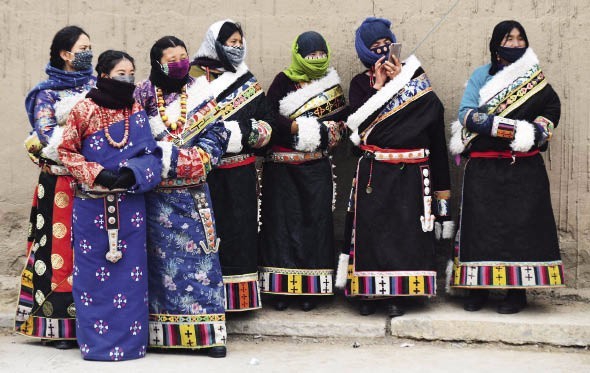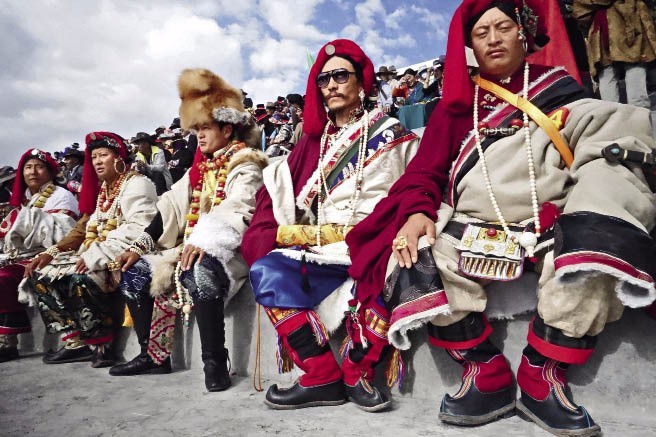In order to adapt to local climate and environment, the Tibetan people living in the snow-capped plateau have developed their distinctive costume. With unique aesthetic tastes, they have perfectly integrated the practical and beautiful aspects into the Tibetan costume.

The unique geographical environment, climate and religious belief of the Tibetan people created a distinctive garment style that resonates with their unique culture.
MORE than 4,000 years ago, the ancestors of the Tibetan people lived in the Yarlung Zangbo River Basin. The unique geographical environment, climate and religious belief of the Tibetan people created a distinctive garment style that resonates with their unique culture.
According to historical evidence, as early as the 11th century BC, there were signs that Tibetan clothing had developed basic modern style. Later, groups living in various parts of Tibet began to communicate with and influence each other, giving rise to costumes which evolved and became more diverse.
Traditional Tibetan clothing has many styles including long-sleeve shirts with high collars, coarse cloth trousers with wide waistlines, long-sleeve leather robes, cloth robes, sleeveless robes, long sleeveless jackets and short sleeveless jackets. There are also accessories like aprons, belts, boots and hats. Materials and workmanship of making them also vary from region to region. The shape and characteristics of the clothing include broad fronted garments, wide waistlines and long sleeves. Generally speaking, the Tibetan costume features robes, casual clothes, and shirts, among which robes are the most common.
Tibetan robes feature broad front, right-folding lapels, wide waistlines, and long wide sleeves. The collar, lapel edge, cuffs, and hems are braided with fine fur, pulu (a kind of wool fabric) or colored cloth. Fabrics vary depending on different regions. For example, Tibetans living in urban areas prefer to choose high-grade wool to make robes, while rurals usually use pulu, and those in pastoral areas favor fur.
Men’s robes are relatively broad with sleeves which make them look masculine and heroic; women’s robes are slightly narrow, which can be divided into sleeved and sleeveless, and can fully show their feminine beauty. Men or women, old or young, wearing a Tibetan robe can vividly show the unrestrained temperament and open-mindedness of this ethnic group.
Getting dressed in Tibetan robes requires a specific sequence. Tibetans first put on their shirts and underwear. Because the robe is longer than the person’s height, they should lift and fold the hem. Generally, men lift it to the knee, while women lift it to the foot, and then tie it with a belt at the waist. The front should be flat and the wrinkles at the back orderly. After the belt is tied, the collar is turned down, and the folded part of the belt lifted at the waist and adjusted to form a wide bag, which can carry some commonly used articles. After donning the robe, the right arm is usually exposed. Some like to tie the sleeves to the waist, expose their arms and high collared shirts, and wear stylish shoes, hats, and various accessories.

A typical Tibetan male costume in Yushu Tibetan Autonomous Prefecture, Qinghai Province.
The climate on the plateau is unpredictable. Tibetans have taken the local climate into consideration and adapted the design of their clothes to suit it. If it is hot, they wear one sleeve or take off both sleeves and tie them on the waist to keep cooler; if it’s cold, they wear both sleeves. This structural feature of Tibetan costume basically determines the full set of the outfit. Meanwhile, the belt becomes an indispensable part.
A Tibetan belt was first hand woven, generally made of cotton, silk, wool, and other materials. Due to the limitation of materials and workmanship, they can only weave equally spaced straight lines, and then weave a variety of colored lines into different sized square patterns. The belt patterns have since evolved with different patterns taking on different meanings. For example, the lotus pattern symbolizes noble and sacred scholars; the dragon and phoenix pattern, peony pattern, and tangled branch pattern symbolize auspiciousness and wealth; while the triangle and broken line pattern symbolize sacred mountains.
In addition to hand-woven belts, there are leather belts which are inlaid with satin and silver belts. Men usually use long ribbons of brown cloth, and colorful silk belts for festivals and dances. Some women’s belts are also made of high-quality cowhide, which are narrow at both ends and wide in the middle. The lining of the belt is made of woolen cloth, brocade, or plain cloth. The top has red inlays and symmetrical patterns finely carved in dyed sheepskin decorated with colored silk thread.
The nobility and wealthy individuals inlay their belts with agate and turquoise, or gild them with silver or gold. During festivals, Tibetans will wear exquisite belts and decorations, sing songs, and dance under the snowy mountain.
Tibetans also like to wear various kinds of ornaments. Tibetan jewelry is rich and diverse and commonly worn. Ornaments can be found in the hair, on the neck, chest, and ears and around the waist. These are mainly made of natural materials and precious metals such as honey wax, pine stone, coral, gold, and silver. People consciously arrange the ornaments according to their own aesthetics, and the effect can be simple, wild, and elegant or mysterious and spiritual. In addition, Tibetans like to wear hats. There are many kinds of hats, such as felt hats, leather hats, and gold flower hats, which add a lot of flair to Tibetan costumes.
In the modern age of communication and travel, Tibetan costume is gradually influenced by external factors. Now, many Tibetan families have added modern clothes, such as suits and jackets, to their wardrobes, reflecting the new taste in clothing. However, during festivals, Tibetans retain their use of traditional dress, which remains an important part of their culture. Under the blue sky and white clouds, the presence of this colorful costume creates a unique ethnic flavor.
___________